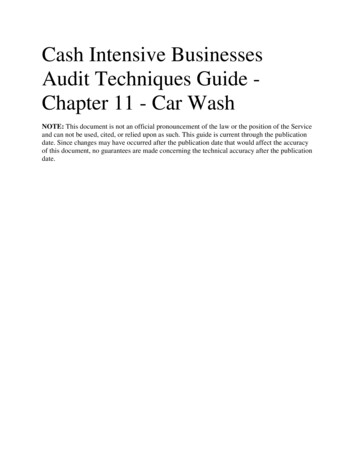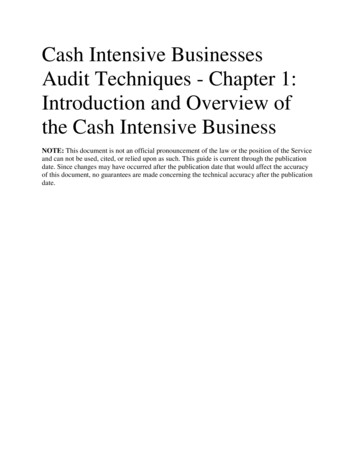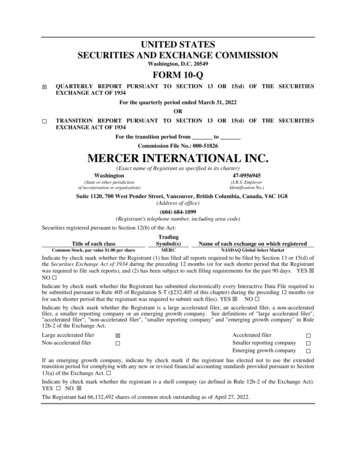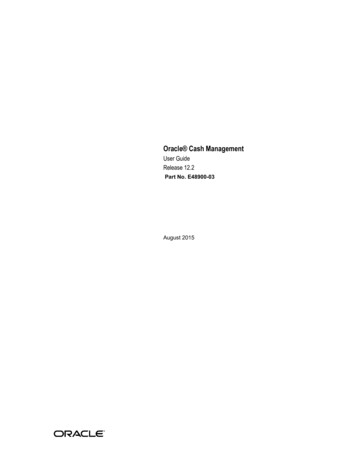
Transcription
Cash Intensive BusinessesAudit Techniques Guide Chapter 11 - Car WashNOTE: This document is not an official pronouncement of the law or the position of the Serviceand can not be used, cited, or relied upon as such. This guide is current through the publicationdate. Since changes may have occurred after the publication date that would affect the accuracyof this document, no guarantees are made concerning the technical accuracy after the publicationdate.
ContentsCar Wash Defined . 3Other Businesses and Services. 3Background . 4Internal Sources of Information . 4External Sources . 5Registry/department of Motor Vehicles. 5State and Local Offices . 6Tax Assessor’s and Collector’s Offices . 6County Registry of Deeds . 6Court Records . 6Local Water Department . 6Local Electric Company . 6Soap/Chemical Manufacturers . 7Equipment Manufacturers. 7The National Weather Service . 7Audit Techniques . 7Income - Gross Receipts . 7Daily Sales Summary Sheets . 7Car Counters . 8Income from Self Serve Activities . 8Consumption Methods . 9Water Consumption Method . 10Water Consumption Analysis Formula . 11Soap/Chemical Consumption Method . 12Soap/Chemical Consumption Analysis Formula . 13Expenses . 13Initial Interview and Information Document Request . 18Initial Document Request for Corporate Car Wash Returns . 20Case Studies . 21Introduction . 21Case Study 1 Gross Receipts - Traditional Indirect Methods . 21Case Study 2 Gross Receipts - Water Consumption. 23Case Study 3 Gross Receipts - Soap/Chemical Consumption . 24Page 1 of 40
Case Study 4 Inventory . 25Case Study 5 Distribution Versus Wages . 27Case Study 6 Net Income from Self Rented Property . 28Case Study 7 Rents Paid in Excess of Fair Rental Value . 28Case Study 8 Lease Versus Purchase. 30Case Study 9 Depreciation of Car Wash Tunnels . 31Case Study 10 Health Benefits Paid by S-Corporation . 32Case Study 11 Imputed Interest on Below-Market Loans . 33Case Study 12 Laon Versus Dividend . 35Glossary . 38Page 2 of 40
Car Wash DefinedA car wash is a facility for cleaning the exterior and sometimes the interior of cars. There aremany different types of car wash service facilities, including:Self-serve bays: Single stall drive-in bay with wands and hoses for hands-on customer use.Options are operated on the wand, and include presoak, wash, double soap, pre-rinse, wheel briteand double rinse. The facilities usually have coin operated vacuums for customer self-use. Selfserve bays are coin operated.Self-serve automatic bay: Single stall with a boom or roll over type mechanism applying water,soap and/or wax at high pressure with cloth or brushes touching the vehicle. Customer usuallyremains in auto. Self serve automatic bays may be coin or token operated, or may be run by anattendant.Self-serve touchless automatic bay: Single stall without any brushes or cloth, only high pressurewater. Options include presoak, wash, double soap, pre-rinse and rinse. Customer usuallyremains in auto. Self serve automatic bays may be coin or token operated, or may be run by anattendant.Full service tunnel: Conveyor belt moves the empty car along a tunnel. The tunnel usually hasbrushes and/or cloth along with high pressure water application and a dryer at the end. Variousoptions include presoak, wheel brite, waxes, undercarriage wash, etc. Employees may also cleanthe inside of the car and wipe it down upon exit.Vending: A variety of towels, fresheners, soaps, etc. are sold on the premises through selfservice vending machines. Snacks and drinks are also sold in vending machines, and the facilitymay have arcade games or other coin operated amusements.Other Businesses and ServicesApproximately 65% of car washes dispense gasoline. Many of those locations show their NAICScode as a gasoline and/or service station, and their car wash facility serves as a secondary sourceof business income.Other car washes provide complete detailing services which are usually done in a shop adjacentto the car wash. Services include cleaning, washing, waxing, shampooing and vacuuming of boththe interior and exterior. This is performed by one or two individuals, and primarily done byhand.Detail shops can also be found as separate stand alone shops and may be separately owned andoperated.Car wash facilities are often adjacent to shops that sell and install mufflers, perform oil changesand provide other miscellaneous auto-mechanical services.Page 3 of 40
BackgroundThe pre-audit portion of any examination can provide a wealth of information prior to the initialcontact or interview with the taxpayer. The more knowledge of the taxpayer and/or the ownersthe examiner has before the examination begins, the easier it is to determine important aspects ofthe taxpayer, such as the assets owned certain items of income, bank accounts, etc. The examinermay also be able to determine the credibility level of the taxpayers based upon their answers toinitial interview questions.Information should be gathered on both the corporate or partnership entity and theshareholder(s)/partner(s) when possible. With respect to a Schedule C, there may be assets orincome information for both the business name and the individual taxpayer. Keep in mind thatwhen performing indirect methods of reconstructing income, the examiner must be prepared todetermine the application of that unreported income (that is, where it was spent or otherwisedisposed of) by performing an indirect method on the shareholder(s) or partner(s). Therefore, themore complete the search is upon both the entity and its owners, the more likely anunderstatement, if any, will be proven.The following sources of information have been divided into two categories: internal andexternal. Internal sources are those available from within the IRS while external sourcesrepresent all others outside the Service. These sources provide information relative to incomeand assets of the taxpayer and may assist the examiner in the classification of a particular taxreturn. The examiner should keep in mind that some of the third party sources may vary fromstate to state relative to the actual information they have, or in the way they store it. Generally,one phone call to that source will enable the examiner to proceed with the information searchfrom that particular party.Internal Sources of InformationInformation on Tax ReturnIn identifying audit potential by using figures per return for a comparative ratio analysis toindustry averages, the examiner must be aware of the large variances in the industry. The taxreturn generally will describe the business activity as "car wash" but does not include adescription of the facility (i.e. full service tunnel, self-service bays, and automatic bays). Thisinformation is necessary in ratio analysis of items (such as supplies, wages, purchases, andutilities) in that those and other items vary considerably, depending upon the facility.Gross receipts will vary depending upon the facility, from self-service bays averaging 1.75 percycle to a full service tunnel which could range from 5.00 to 14.00 (i.e. per car wash). Manycar washes issue and accept a variety of discount coupons which entitle the bearer to a discountranging from 1.00 off to a free wash. Often the gross receipts are reported at net after couponsand discounts which skew the income shown on the return. Also, while gross receipts mayinclude vacuum, vending and other items sold or detailing services rendered which could skewPage 4 of 40
the gross receipts from the industry average, the agent will not know of their inclusion until theinitial interview.Water and sewer expense will vary based on whether the taxpayer has a well or town/city waterand sewer hookups. With well water, there are no city charges for water use and generally nosewer charges either, as sewer charges are usually determined from the water meter. Reclaimsystems also affect these expenses as water use is greatly reduced due to the recycling.Electricity expense will differ from location to location, according to the equipment being used.Self-service bays use the least amount of electricity, while the full service tunnels use the most.In addition, rates vary from town to town which will affect the dollar amount of the deductionper the return.Cost of goods sold is presented in a variety of ways on car wash tax returns. Car washpurchases/inventories generally consist of soaps and chemicals. Purchases could also includeother costs such as utilities, water, and sewer, as they can be considered costs of the product.Some taxpayers do not show any inventory because they consider it de minimis. Occasionally,no amounts appear in the cost of goods sold section, as they are reflected under "otherdeductions" in the general and administrative expense section of the tax return. These variablesmake ratio analysis of gross profit percentages impossible.In addition, purchases of soaps and chemicals vary based on the type of facility. Self-servicebays use considerably less chemicals than either the automatic bays or full service tunnels.Repair and maintenance expense is a constant and ongoing activity in any type of car wash. Theamount expended will be directly related to the condition and use of building and equipment andthe level of expertise of the owner.External SourcesRegistry/department of Motor VehiclesMany states motor vehicle departments have a Special Procedures Section, perhaps associatedwith their Collection Division, which has the motor vehicle information on a database and iseasily accessed by the Special Procedures employee. If this service is not available in theexaminer’s district, in most instances he or she may contact the registry directly. Data may besearched by an owner’s name, driver’s license number, social security number or license platenumber of a particular vehicle.The examiner can obtain a listing of all vehicles registered to that individual or entity and theirdate of purchase, latest renewal information, the lienholder or lessor, and the VIN. Also availableis information such as the owner’s, last known address as furnished by the party, date of birthand description of the individual. Often this information can lead to additional sources of incomeor other bank accounts (for example, the loan application from a lender, or the insurance policywhich may list vehicles not currently registered, but insured).Page 5 of 40
State and Local OfficesThe Secretary of State’s Office has a record of all corporations and their officers which can beused to identify shareholders. The city or local town hall maintains a record of all "dba’s" (doingbusiness as) for the locality and will provide the owner of record for all unincorporatedbusinesses.Tax Assessor’s and Collector’s OfficesReal and personal property assessed values and tax bills are maintained at this level and containinformation such as property descriptions, owners of record and address, appraised values and inthe case of real property, the book and page number in the registry of deeds for the quitclaimdeed of the current owner.County Registry of DeedsAll real property is recorded at the Registry of Deeds either in the land court or records section.In most instances, the examiner will need to know the year of sale/purchase and the owner’sname to search for property. Deeds reflect the buyer and seller name and address, the amount ofconsideration and the property’s legal description. These documents provide information of assettransactions for a particular taxpayer and possible taxable transactions. The examiner may usethis information or follow-up on third party sources discovered such as lenders and other parties,and find still other sources of unreported income. Also recorded in the Registry of Deeds aretrust instruments, partnership agreements, leases, liens, and judgments which can also lead toownership of other assets under yet another name or entity in which the taxpayer is involved.Court RecordsThe courts maintain records which can provide valuable audit information, such as divorcesettlements, probate matters, bankruptcy and other legal proceedings. Information relative toproperty transfers, assets, and other financial information of the parties may be found here.Local Water DepartmentThis department maintains records on water use, usually by the billing records. This will behelpful if the taxpayer does not keep water bills and the examiner needs to verify the expense orthe number of gallons used during a particular time period. This party will also be able to furnishthe examiner with information relative to the water pressure being furnished to the facility shouldit be needed for an indirect method.Local Electric CompanyAs with the water department, information on electric usage may be retrieved from this source.This will be helpful should the examiner need to verify the electric expense deduction orascertain the electric usage for an indirect method.Page 6 of 40
Soap/Chemical ManufacturersThese sources may be contacted should the examiner need information on total purchases madeby the taxpayer. The manufacturer’s representatives may be helpful in determining soap orchemical dilution rates or the number of vehicles serviced by a unit of their products should theexaminer need this information when reconstructing income.Equipment ManufacturersThese companies will be able to provide the examiner with specifics as to water usage andsometimes electrical usage for their equipment. There may be a number of factors which skewactual usages, especially if the taxpayer did not use the company’s representatives to install themachinery, or did not abide by their installation requirements. However, this source can stillprovide the examiner with information which will be helpful in the examiner’s gross incomereconstruction.The National Weather ServiceThe examiner may need to contact this agency to verify the taxpayer’s records if they reflect that,for instance, the car wash was closed for a week due to inclement weather. Also, the examinermay need to retrieve information as to temperatures to verify the number of days the taxpayer’sweep system was engaged.Audit TechniquesIncome - Gross ReceiptsA car wash is a cash intensive business, therefore, it is important to perform an in-depth test ofgross receipts.Many taxpayers arrive at their gross receipts per the tax return by simply adding up deposits totheir business bank account(s). Due to the cash intensive nature of the car wash business it wouldbe easy for a portion of the taxpayer’s gross receipts not to be deposited and, therefore, notreported.The first test of the taxpayer’s gross receipts should be a direct test of the taxpayer’s grossreceipts records. The following are various direct and indirect tests that may be useful in theexamination.Daily Sales Summary SheetsMany full serve tunnel car wash businesses have employees and the owner/shareholder mayrequire employees to complete a daily sales summary sheet at the end of their shift. Thesesummary sheets usually itemize the number of cars washed, extras sold, and total moniesPage 7 of 40
collected. The examiner should select a test period and tie in the total monies collected with thedeposits.Car CountersOwners/shareholders sometimes install more than one car counter, particularly when they haveemployees, to ensure that employees are not misappropriating monies. The examiner candetermine the reasonableness of the taxpayer’s reported gross receipts by analyzing the carcounter records maintained by the taxpayer.Example 1Total cars washed during the year per car counter records 45,500 times the average car washprice x 6.00 ( 5.00 basic wash 1.00 menu options) equals an estimated Car Wash GrossReceipts 273,000Income from Self Serve ActivitiesSales from self serve bays; vacuum and vending (air fresheners, polish, towels, etc.) mayrepresent a substantial portion of the taxpayer’s gross receipts. These sales have fewer controlsthan the full serve tunnel car wash sales. Generally, it is the owner/shareholder who empties thecoins out of the machines and many times there are no records kept on the amount of moneycollected.a. If the self serve bays, vacuum and vending machines have counters and records aremaintained, the examiner can analyze these counter records and determine thereasonableness of the taxpayer’s income from self-service activities. (The examinershould use an analysis similar to the one shown above for car wash sales.)b. Also, most car washes have bill changers, where customers will convert dollar bills intoquarters then use these quarters in the self-serve bays, vacuum and vending machines.These bill changers usually have counters. If the records are available the examiner maybe able to use these records to perform another test of the taxpayer’s income from selfserve activities.It is important to note that there is no direct correlation between the amount of bills converted tocoins and the amount of income generated by the business activities. The customer converting abill into coins does not necessarily deposit all of the coins into one of the taxpayer’s machines.Also, some customers may not use the bill changer if they already have enough coins to operatethe taxpayer’s machines.During the initial interview the examiner can ask the owner/shareholder to determine thepercentage of customers that use the bill changer but do not use the quarters in one of thetaxpayer’s machines, and to determine the percentage of customers that do not use the billchanger but do deposit coins into one of the taxpayer’s machines.Page 8 of 40
Due to the estimates described above, this test of the taxpayer’s self-serve activities incomeshould be used as an indicator of unreported income when the taxpayer doesn’t have any recordsand the examiner has to reconstruct income.Example 2Number of bills converted to coins per counters 950,000.00Less: dollars converted but not deposited into one of the taxpayer’s machines(95,000.00)Add: coins that didn’t come from taxpayer’s bill changer but were depositedinto one of the taxpayer’s machines 50,000.00Estimated self serve activities income 905,000Due to inadequate internal controls, all the car washes examined during this project required theuse of indirect methods to test income.During these examinations the team performed at least two indirect methods on the car washbusiness (primarily corporations) and the team also performed at least one indirect method on theshareholder’s tax return.On the car wash business, the team generally performed a bank deposit analysis and aconsumption method, which is described later in this chapter.Note: Due to the many variables present in the consumption methods, Counsel would not upholda proposed adjustment solely based on a consumption method. Therefore, it is suggested that theconsumption methods should just be used to show an indication of unreported income and not asthe sole basis for a proposed adjustment.On the shareholder’s tax return a bank deposit analysis and/or a cash transaction analysis (CashT) were performed. The team concluded that any income probe of a car wash business shouldinclude an examination of the owner/shareholder’s tax return. The audit procedures shouldinclude a bank deposit analysis, cash transaction analysis, and an evaluation of theowner/shareholder’s standard of living. Form 4822, Statement of Annual Estimated Personal andFamily Expenses, can be used to assist in this analysis.Consumption MethodsThe consumption methods described below reconstruct the taxpayer’s income by determining thenumber of cars that were washed based on the amount of water, soap, or chemicals consumed.The consumption formulas contain many variables and estimates which, if not accurate, canskew the results considerably. The team determined that the consumption methods should beused as an indicator of unreported income, when the taxpayer does not have any records and theexaminer has to reconstruct the taxpayer’s income. The team also concluded that another indirectPage 9 of 40
method should be performed on each taxpayer to ensure that the taxpayer’s gross receipts arecorrect and that any proposed adjustment will be sustained at the Appeals and Counsel levels.Water Consumption MethodThe number of gallons of water used per cycle may be difficult to determine. It should be notedthat there will rarely, if ever, be one specific value for this factor, therefore it will be necessary tocompute a value which will represent an estimated number of gallons per cycle. There are,however, certain techniques which can be utilized to arrive at a figure which will represent ausable and relatively accurate number.One technique is to be on site during the business day to inspect the operations while they areunderway and read the water meter(s) as the cars are being washed. Taking a reading before andafter a cycle is completed is the best way of determining the basic number of cubic feet used.The following are suggested techniques for reading water meter(s) and for otherwise determiningthe amount of water usage:Take as many as 10 readings (or more as circumstances warrant) and fluctuate the number ofcycles between readings. For example, take one or two readings before and after one cycle, a fewmore readings before and after 3 or 4 cycles, and still another sample of readings after 6 or 7cycles have passed. This insures that the examiner has sufficient data to arrive at a reasonablyaccurate value.Water consumption on the meter is always measured in cubic feet rather than gallons. Once thenumber of cubic feet has been determined, multiply the number of cubic feet times 7.48 to arriveat the equivalent number of gallons used.The number of gallons will fluctuate based upon the services ordered by the customer. Forexample, a basic wash may use "X" gallons whereas "super deluxe" type option may use morewater during the wash or rinse cycle.The number of gallons of water used per cycle may be difficult to determine. It should be notedthat there will rarely, if ever, be one specific value for this factor, therefore it will be necessary tocompute a value which will represent an estimated number of gallons per cycle. There are,however, certain techniques which can be utilized to arrive at a figure which will represent ausable and relatively accurate number.For self service bays, the water use depends on the customer’s use of the "wand". They maydesire more soap and less water than the customer before or after them. However, throughout theindustry there are certain parameters and maximums which can be quantified. The end result isthat most customers end up using roughly the same amount of gallons of water per self servecycle.In addition to the meter reading and bucket filling techniques, the equipment manufacturer mayhave basic parameters regarding water usage of their equipment, and may be even more specificif their company or an authorized representative performed the installation. When contacting thePage 10 of 40
manufacturer, it is recommended to have all information relative to installation (particularly withrespect to any variations from the manufacturer’s specifications). Also, contacting the local waterdepartment to retrieve information as to the water pressure being supplied to the facility willassist the manufacturer in determining number of gallons per cycle.Water loss through the weep system. The weep system is a mechanism which allows water todrip or "weep" throughout the system to prevent water from freezing in the pipes during thewinter. Once the examiner determines the rate of water loss from the system, and also hasverified that this weep water is in fact lost and not reused in the system, he/she needs todetermine just how often the system was turned on during the year. During the initial interview,the taxpayer should have told the examiner the temperature at which the system is engaged.Usually the temperature ranges from 34 to 40 degrees Fahrenheit.Other water losses that may have to be accounted for include, washing down tunnels and parkinglots, free and rewashes, washing machines for towels and rest room facilities.Water Consumption Analysis FormulaThe consumption formulas contain many variables and estimates which will skew the results ineither direction; therefore they should only be used as an indicator in testing gross receipts. Inaddition to a consumption formula, one or more traditional methods of testing income should beperformed (bank deposit analysis, cash transaction analysis, source and application of funds,and/or a net worth method). This is necessary to ensure that the examiner’s income adjustmentand/or civil fraud penalty will be sustained at both the Appeals and Counsel levels.The first factor the examiner needs to determine is the total number of gallons used in aparticular tax year by the taxpayer.The examiner can usually obtain the water meter readings from the water bills. The water meterreadings are expressed in cubic feet (or hundred cubic feet) and must be converted into gallons inorder to use this value in the water consumption formulas. Also, the water meters are usuallyread in 6 month intervals but are rarely read by the water company on the first and/or last day ofthe tax year. Therefore the examiner may need to annualize the usage by using those readingsclosest to the tax year dates.Other items needed such as number of gallons per cycle, water losses, prices per cycle andvacuum and vending sales will be gathered at the initial interview and on-site testing of watermeters.By taking the Ending Reading from the water bills and subtracting the beginning Reading youwill get the amount of water used for that period of time. Then:A. Take the number of months between Readings and divided into the amount of water usedto get the Average Monthly UseB. Once you figure out the Average Month Use times it by the months In Ta
Car Wash Defined A car wash is a facility for cleaning the exterior and sometimes the interior of cars. There are many different types of car wash service facilities, including: Self-serve bays: Single stall drive-in bay with wands and hoses for hands-on customer use. Options are operated on the wand, and include presoak, wash, double soap, pre .











